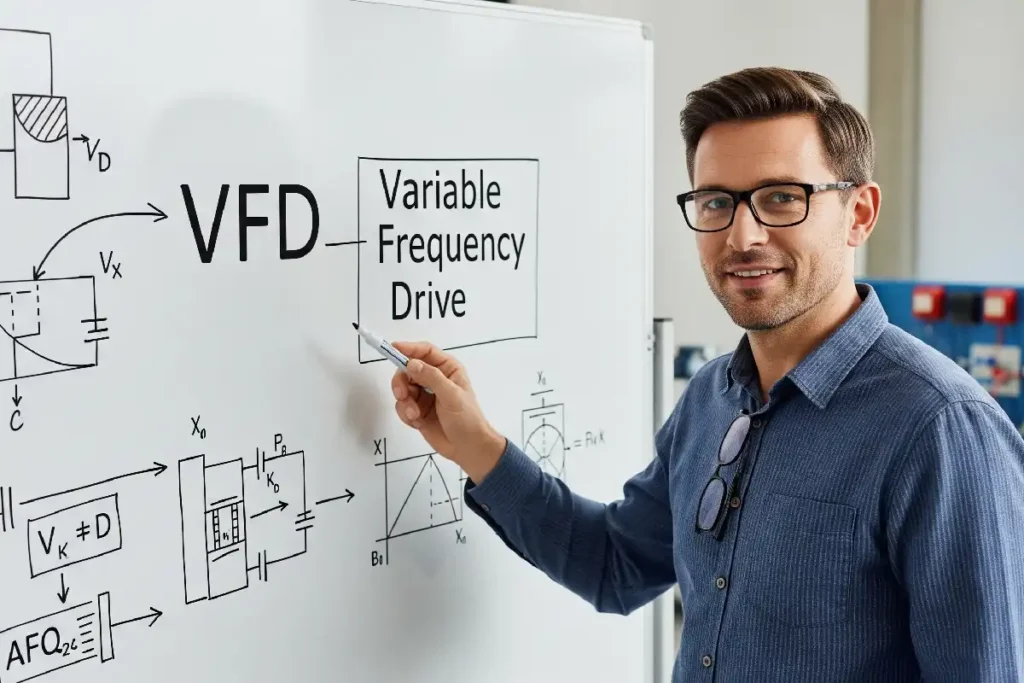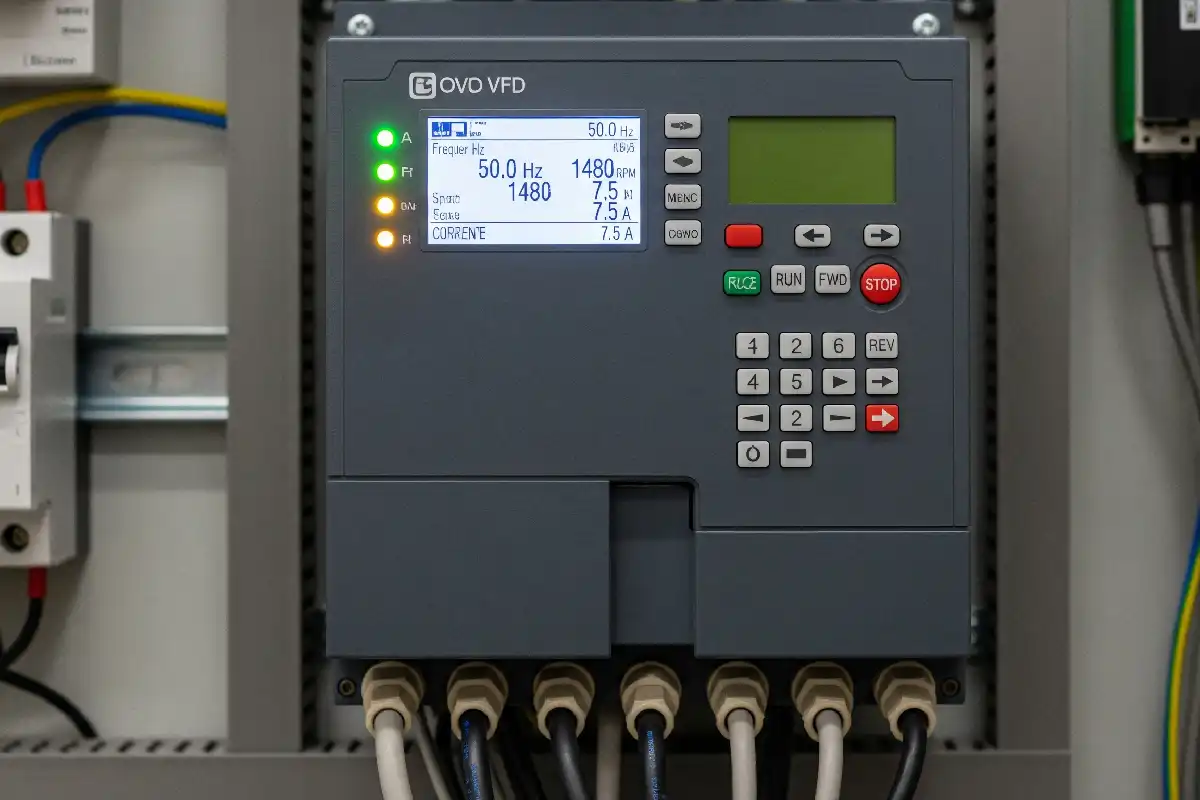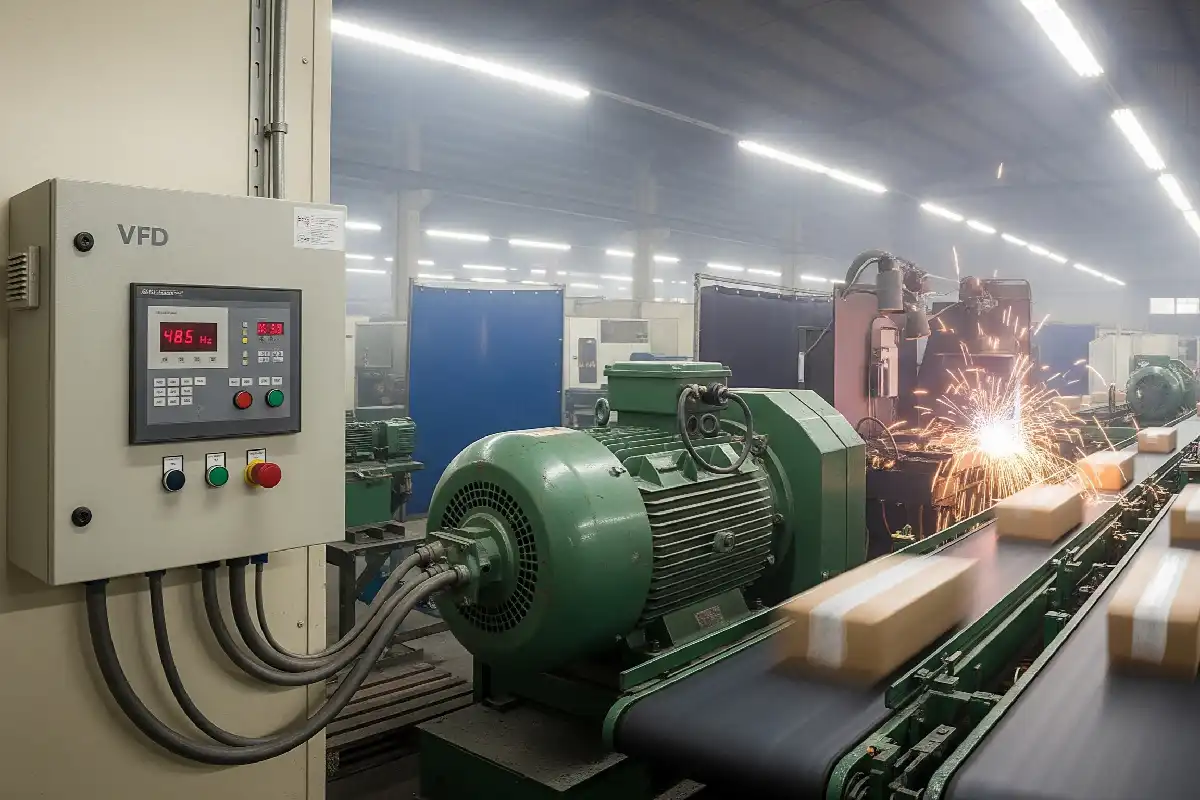VFD means variable frequency drive in electrical engineering. People use the vfd electrical full name when they talk about devices that change how fast an electric motor goes. Knowing the vfd electrical full name helps you see how it saves energy and controls motors.
| Metric | Value | Explanation |
|---|---|---|
| Percentage of global VFD demand from industrial applications | 47% | The industrial sector uses almost half of all VFDs in the world in 2023 |
- The name variable frequency drive shows how a vfd changes frequency and voltage. This helps the motor speed match what is needed. It saves energy and helps the motor last longer.
Key Takeaways
- A VFD means Variable Frequency Drive. It controls how fast AC motors spin by changing the frequency and voltage.
- Using a VFD helps save energy. It also makes motors last longer and cuts down on electricity bills by matching the motor speed to the work needed.
- VFDs change AC power into DC power. Then, they turn it back into AC with different frequency and voltage. This lets the motor run smoothly.
- There are different kinds of VFDs. They give exact control of speed and torque for machines like pumps, fans, and conveyors.
- Many industries, buildings, and homes use VFDs. They help things work better, save money, and protect the environment.
VFD Electrical Full Name
What Is VFD?
You might see the vfd electrical full name in books and guides. VFD means variable frequency drive. This device helps you change how fast an AC motor spins. It does this by changing the frequency and voltage of the power. With a vfd, you can make a motor go faster or slower. This depends on what your machine needs. The official name is variable frequency drive in electrical engineering. People use a vfd to control motor speed, save energy, and make machines work better.
If you know the vfd electrical full name, you know it is a controller, inverter, and feedback device working together. The controller picks the speed. The inverter changes the power. The feedback device checks how things are working. These parts work as a team to keep motors safe and running well.
Variable Frequency Drive
A variable frequency drive is a kind of motor controller. You use it to run an electric AC motor by changing the voltage and frequency. The vfd electrical full name tells you it changes frequency to control speed. You can find variable frequency drives in pumps, fans, and conveyors. They are also in many other machines. These drives help save energy. Motors without vfds always run at full speed. This wastes power and wears out the motor.
| VFD Component | Description |
|---|---|
| Rectifier/Converter | Changes AC voltage to DC voltage. |
| DC Bus | Stores and smooths DC power using capacitors. |
| Inverter | Converts DC back to AC with controlled frequency and voltage for the motor. |
Each vfd part has a job. The rectifier changes the power. The DC bus stores the power. The inverter sends power to the motor at the right speed.
Other Names
People sometimes use other names for the vfd electrical full name. Here are some common ones:
- variable speed drive
- adjustable speed drive
- AFD
- frequency drive
- inverter
- AC Drive
- motor drive
- vector drive
- frequency inverter
- adjustable frequency drive
- frequency converter
You should know a variable frequency drive is not the same as a variable speed drive. A vfd controls AC motor speed by changing frequency and voltage. A variable speed drive is a bigger group. It includes vfds and other devices that control both AC and DC motors. These use different ways, like voltage control or eddy current coupling. You use a vfd when you need to control AC motor speed exactly. You use a variable speed drive when you want to control speed for many types of motors.
Knowing the vfd electrical full name and other names helps you pick the right device for your job. You will not get confused and can make better choices for motor control and saving energy.
If you understand these words, you can use less energy, make motors last longer, and fix problems faster. When you know the difference between a vfd, a frequency inverter, and a frequency converter, you can solve problems and pick the best tool for your needs.
VFD Function and Operation
Purpose
A vfd helps you control the speed and direction of an electric motor. You use a vfd to match the motor speed to what your machine needs. This saves energy and makes your equipment last longer. Here is what a vfd does in a motor control system:
- It regulates the power flow from the electrical supply to the motor.
- It lets you adjust the speed and torque of the electric motor.
- It replaces old motor starters and gives you more control, like smooth starting and stopping.
- It helps lower noise and maintenance costs.
- You can use a vfd in pumps, fans, conveyors, and compressors.
A vfd is an important motor controller for many machines. It gives you precise motor speed control and helps your system run better.
How VFD Works
A vfd changes the way power moves from the wall to your electric motor. It does this in three main steps:
- The vfd takes in AC power and uses a rectifier to turn it into DC power.
- The DC power goes into a DC bus, which smooths and stores the energy.
- The inverter part of the vfd changes the DC back into AC power, but now you can set the frequency and voltage.
You control the speed of your electric motor by changing the frequency of the AC power. The vfd also changes the voltage at the same time to keep the motor running smoothly. This method is called V/Hz control. For example, if you cut the frequency in half, the vfd also cuts the voltage in half. This keeps the motor working well and stops it from overheating.
A frequency inverter uses special switches called IGBTs to make these changes fast and accurate. The inverter uses pulse width modulation (PWM) to create the right AC output for your motor. This lets you start, stop, and change speed smoothly. You get better motor speed control and less wear on your equipment.
With a vfd, you can match the motor speed to your process. This means you use only the energy you need and avoid wasting power.
Main Types
You can find different types of vfds for different jobs. The main types depend on how they handle power and what kind of control they give you. Here is a table to help you see the differences:
| VFD Type | Description | Key Benefits |
|---|---|---|
| Voltage-Source Inverter (VSI) | Changes AC to DC, then back to AC using PWM for precise speed and torque control | Works with many motors, gives smooth control, saves energy |
| Current-Source Inverter (CSI) | Uses special switches for high speed and strong braking | Less distortion, fast changes, good for tough jobs |
| Direct Torque Control (DTC) | Controls motor torque and magnetic field directly | Fast and accurate, less torque ripple, very efficient |
You may also hear about ac drive types based on input and output:
- AC input vfds take AC power, turn it into DC, then back to AC for the motor.
- DC input vfds take DC power directly and use it to control the motor.
- All vfds give you AC output with variable frequency and voltage for your electric motor.
A frequency inverter can use different control methods, like V/Hz scalar control, sensorless vector control, or direct torque control. Each method gives you a different level of precision and speed control. You pick the type that fits your machine and process best.
Knowing the main types of vfds helps you choose the right motor controller for your needs. You can get the best performance and energy savings for your electric motor.
Benefits and Drawbacks
Advantages
Using a vfd gives your motor system many good things. The biggest benefit is saving energy. You can change motor speed for each job. This means you use less electricity. Factories and buildings save money with vfds.
- You can save up to 50% energy with fans and pumps. Some water pumps have saved as much as 85%.
- VFDs help you control motor speed better. You only use the power you need. This stops you from wasting energy.
- You save money because your bills go down. Your equipment lasts longer too.
- VFDs let motors start and stop smoothly. This lowers stress on parts and means less fixing.
- You get better power factor and lower peak charges. This helps you manage energy better.
- When motor speed matches what you need, you work faster. Your system runs well and does more.
| Application/Context | Energy Savings (%) | Notes |
|---|---|---|
| General industrial motor systems | 20 – 60 | Most motors save this much energy with VFDs |
| Individual motor loads | Up to 80 | Some motors save even more energy |
| Fans and pumps (variable torque) | ~40 | Savings depend on how the fan or pump works |
| 20% reduction in motor speed | ~50 | Cutting speed by 20% can save half the energy |
Tip: Use a vfd if you want to save energy and make your motor last longer.
Limitations
There are some problems with vfds you should know. Not every motor works well with them.
- Some motors, especially old ones, do not work with vfds. Always check before you use one.
- VFDs can make harmonic distortion. This can hurt sensitive equipment. You may need special filters.
- VFDs cost more than simple starters. You pay more at first for better control.
- Setting up and programming vfds can be hard. You might need an expert to help.
- If vfd frequency matches your system’s vibration, it can shake too much.
- VFDs can make electrical noise and bearing currents. These can damage motors if not fixed.
- Hot places and bad airflow can make vfds wear out faster. You need to protect them.
Note: Picking the right vfd, installing it well, and taking care of it helps you avoid most problems and get the best results.
Applications of VFD
Industrial Uses
VFDs are used in many industries to control machines. They help save energy and make equipment last longer. When you use a VFD, you can change how fast a motor goes. This means you only use the power you need. Some places that use VFDs are:
- Water and wastewater treatment plants
- Oil and gas facilities
- Metals and mining operations
- HVAC systems in factories
- Power generation and renewable energy sites
- Food and beverage processing
- Cement and chemical plants
You see VFDs in pumps, fans, conveyors, and compressors. These machines use less energy with VFDs. They also break down less and need fewer repairs. For example, in water plants, VFDs let you change pump speed for the right water flow. This saves money and electricity. Factories use VFDs to control big motors. These motors use a lot of energy. With VFDs, you can save between 20% and 65% on energy for pumps and fans.
VFDs help the environment by using less power and making less pollution. When you set the motor speed for the job, you waste less energy.
Commercial and Residential
VFDs are also found in big buildings and homes. They help control heating, cooling, and air systems. You can use a VFD to change fan and pump speeds. This keeps rooms comfortable and saves energy. In hotels and offices, VFDs run pumps to keep water pressure steady. Pools use VFDs to change water flow and save electricity.
- HVAC systems: VFDs control fans and pumps for better air and lower bills.
- Pressure booster pumps: VFDs keep water pressure even in tall buildings.
- Swimming pool filtration: VFDs use just enough power to clean the water.
Using VFDs in these systems makes equipment last longer. It also means you pay less for repairs. VFDs help keep buildings quiet and comfortable too.
Everyday Examples
VFDs are in some home appliances you use every day. Washing machines use VFDs to change drum speed for each wash. This cleans clothes better and protects the machine. Dishwashers use VFDs to control pump speed. This helps save energy and clean dishes well.
- Washing machines: VFDs change drum speed for better cleaning and less damage.
- Dishwashers: VFDs control water pumps to use less power and clean dishes.
More people want to save energy, so VFDs are in more home devices. The VFD market is growing fast and is expected to keep rising by over 5% each year until 2030.
You have learned that vfd means variable frequency drive. This device lets you change how fast a motor goes. It helps machines work better and last longer.
- VFDs change the frequency and voltage to save energy and money.
- They help machines last longer by lowering wear and tear.
- You can use VFDs in many places, like pumps and HVAC systems.
- VFDs help the planet by cutting down on pollution and saving resources.
When you know what a vfd does, you can make good choices to control motors and save energy.
FAQ
What does a VFD do in simple terms?
A VFD lets you change how fast an electric motor runs. You can make the motor go faster or slower. This helps you save energy and control machines better.
What types of motors work with VFDs?
You use VFDs with AC motors, especially three-phase induction motors. Some newer VFDs also work with permanent magnet motors. Always check your motor type before you connect a VFD.
What problems can a VFD cause?
A VFD can create electrical noise and heat. Sometimes, it causes harmonics that affect other equipment. You may need filters or special cables to fix these problems.
What is the difference between a VFD and a VSD?
A VFD controls the speed of AC motors by changing frequency and voltage. A VSD is a broader term. It includes VFDs and other devices that control both AC and DC motors.
What should you check before installing a VFD?
Check your motor’s compatibility, power supply, and cooling needs. Make sure you have the right cables and protection devices. Read the VFD manual for safety tips.
See also
What Is the Full Name of ELCB in Electrical Engineering
What Are the Basic Elements That Determine Circuit Breaker Quality
How to Calculate Circuit Breaker Tripping Time Accurately with Trip Curves
Best DC Miniature Circuit Breaker for Solar Systems
What are the expert-recommended brands of miniature circuit breakers





